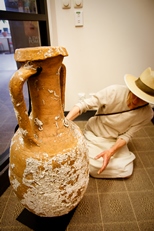The Classics Museum houses a small collection of Greek and Roman artefacts, not all of which are on display. Some have been purchased by the Classics programme, while others are on loan from the British Museum, National Museum of Athens or private owners.
Contact the Programme Administrator to arrange access to the Classics Museum. We provide free tours for school groups.

Our latest acquisition is a Hellenistic theatrical mask of pinkish buff-brown terracotta, fired with some reddish-brown pigmentation apparently remaining in the hair. A complete work, the mask is typical of Pollux' category The Admirable Young Man, with pierced pupils and open mouth.
It provides a striking three-dimensional example of theatrical headgear as well as a focal point for discussion of terracotta technique and technology in both Greece and Italy.

An Etruscan antefix was acquired in 2003. Such a device would have been attached to the edge of the roof of a temple or shrine. This example dates to the late 6th-early 5th century (approx. 515-485) BCE. It shows the head of a grinning, bearded gorgon, whose hair is represented by two archaic beaded black locks, which would be mirrored on the other side of the face, if complete. Gorgons were commonly represented in Etruscan art to ward off evil.

A Roman portrait head of a woman, probably from the eastern Mediterranean region, was also acquired in 2003. It dates to the reign of the emperor Antoninus Pius, (138-161 CE) or possibly into the mid-3rd century.
Between her right eye and nose is a mole, an unusual individualising feature that suggests the portrait is of an actual person and not just an idealised woman.
The marble used may have been imported from Attica. In provinces where marble was in short supply, the back and sides of a head might be pieced together, as that part of the statue would be less likely to be viewed closely. Hence, this head has been hollowed at the back in antiquity for the attachment of additional and separate pieces of coiffure (hair).

This child's sarcophagus is another of the Museum's more recent acquisitions. Made of marble in the 3rd century CE, it measures 88cm (34.4") long by 28cm (11") high.
The inscription reads:
'to the gods, and the shades of the dead Serianus Ciartius had [this] made for Albius Graptus who lived scarcely 3 years'.

Other recent acquisitions have included a coin of Cleopatra, a coin of Hadrian, and a beautiful black figure kalpis featuring an octopus with eight symmetrically arranged tentacles drawn in silhouette on the front shoulder.
The earliest pieces on display in the Museum include a piece of flint which appears to have an edge chipped and shaped to form a tool or blade. There are also several sherds of Burnished Ware pottery from the Neolithic Period (6000-3000 BCE).

The Early Bronze Age (3000-2000 BCE) is represented by a small Cycladic figurine, a stylised marble figure of a nude woman, made in the Greek islands. An undecorated Cypriot flask is of similar date.
A number of pottery sherds from the Middle Bronze Age (2000-1550 BCE) are on display. These include an example of Helladic (Greek) Grey Minyan Ware which looks rather metallic, and a fine piece of Minoan (Cretan) Kamares Ware, a thin-walled, delicate pottery.
From the Late Bronze Age (1550-1000 BCE) we have two painted jars made at Mycenae on the Greek mainland.
The Bronze Age is followed by the Geometric Period (1000-700 BCE) which is represented by an Attic oinochoe, or pitcher, with wide mouth, and a somewhat damaged trefoil oenochoe, also Attic (ie, from Athens). There are statuettes of a flute player and mother with child, possibly from Crete.
From the Orientalising Period (700-600 BCE) there are a number of small Corinthian vases including a concave pyxis (box) with friezes of animals and an aryballos with a procession of warriors with shields.

From the Archaic Period (600-480 BCE), we have a number of vases in the Attic black figure style: several lekythoi (jugs or cruets), an olpe with Achilles slaying Penthesilea, a neck amphora with satyrs carrying maenads, and a kylix or cup (inscribed) with two silens running, one on either side of the vase.
From the Classical Period (480-323 BCE) we exhibit a white ground aryballos illustrated with a winged Nike (Victory), as well as a white ground lekythos with a nude male figure wearing a petasos (a travelling hat). For the fifth century red figure style, see the Attic red figure lekythos with a boy before an altar, and the damaged red figure lekythos with a Nike. Two large bell craters made in Southern Italy in the fourth century BCE also belong to the red figure style. One features (side A) a satyr and maenad, the other (side A) a maenad with a seated Dionysus holding a tragic mask. In addition, a red figure fish plate attributed to the Eyebrow Painter is South Italian (Apulian).

The latest jug in the collection is the Gnathian epichysis (c.330 BCE) decorated with applied masks and a coloured floral design above a meander pattern. The Gnathia style is so called after Egnazia in Southern Italy where many of these vases were found. Etruscan pottery from central and Northern Italy is represented in the collection by a burnished black bucchero kyathos (6th century BCE) without painted decoration, and an impasto skyphos.

There are several Roman terracotta oil lamps and a pitcher, in addition to a number of Roman glass bottles (c.100 BCE - 100 CE). See also the scale model of the Pantheon modified to its current form in the second century.
Three dimensional art is represented by a number of terracotta figurines and moldings as well as a marble female head probably from the Late Classical or Hellenistic period (400 BCE - 31 CE). Miscellaneous objects include a clay loom weight, spindle whorls, and bronze nails.
